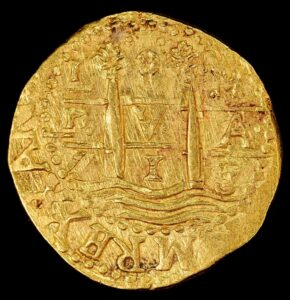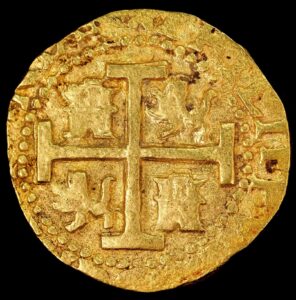
Rare 1713/12 Lima 8 Escudos NGC MS-62 Shipwreck Coin!
This is a superb mint state example of a rare Lima 8 Escudos minted in 1713 during the reign of King Philip V.
Item #CC-0496 | Rare 1713/12 Lima 8 Escudos NGC MS-62 Shipwreck Coin
Mint: Lima, Peru
Assayer: “M” for Cristobal Cano Melgarejo
Ruler/Period: King Philip V
Grade: NGC MS-62
Mintage: 40,295 (According to NGC)
For details and population on this coin from NGC, click on the serial number here: 6877214-001
 Description: This is an exceptionally rare mint state example of a 1713 over 12 Lima 8 escudos, that is most likely a survivor of the 1715 Spanish Fleet that sunk on July 31st 1715 off the East coast of Florida. Spanish Colonial gold, especially gold cobs minted in Lima are very rare and highly sought after. With only a total of (10) 1713/12 coins graded by NGC, only 5 are graded in mint state and only 3 are graded higher than MS-62. This specimen is the one and only MS-62. To better illustrate the rarity of this piece, NGC has graded a total of (19) 1708’s with 12 graded in mint state, (44) 1711’s with 26 graded in mint state, and (81) 1712’s with 55 graded in mint state. These statistics indicate that this 1713/12 overdate variety is ten times rarer than the 1712!
Description: This is an exceptionally rare mint state example of a 1713 over 12 Lima 8 escudos, that is most likely a survivor of the 1715 Spanish Fleet that sunk on July 31st 1715 off the East coast of Florida. Spanish Colonial gold, especially gold cobs minted in Lima are very rare and highly sought after. With only a total of (10) 1713/12 coins graded by NGC, only 5 are graded in mint state and only 3 are graded higher than MS-62. This specimen is the one and only MS-62. To better illustrate the rarity of this piece, NGC has graded a total of (19) 1708’s with 12 graded in mint state, (44) 1711’s with 26 graded in mint state, and (81) 1712’s with 55 graded in mint state. These statistics indicate that this 1713/12 overdate variety is ten times rarer than the 1712!
To provide some reference of value, a 1712 Lima 8 escudos graded by NGC as MS-62 sold on 8/15/2024 on a Heritage ANA World & Ancient Coins Platinum Session and Signature® Auction #3118 / Lot #33240 for $37,200.00. You can see the price realized here.
Then, a 1705 Lima 8 Escudos graded by NGC as AU-58 sold on 11/2/23 on Sedwick’s auction #34, lot #35 for $37,500 ($31,250 hammer price plus buyers premium), See the catalog listing here. At this writing, the 1705 has a total graded population by NGC of (13) with 6 in mint state, which makes this date comparable to the 1713/12. The main difference in value and rarity here is that the 1713/12 specimen shown here is 3 grades higher.
The market for Lima 8 Escudos seems to be increasing about 10%-15% per year and with more and more collectors looking to own one of these spectacular and historically rich coins, the price will likely continue to increase as the demand is rapidly depleting the supply.
Unlike milled coins or modern era coinage, no two gold cobs are exactly the same as these types of coins were struck by hand with a hammer and dies. Oftentimes, as is noticeable on the pillar side of this example, the coins are struck more than once which accounts for the “doubling” effect, which misaligns some of the design elements on the die onto the coin surface.
The pillar side of this coin displays the pillars of Hercules rising from the waves with chapiters atop each. The letters and number in the center portion of this 1713 specimen shows (L -8- M over P.V.A.), which represents the following: The “L” is for the Lima mint, the 8 is for the denomination of 8 escudos, “M” is for the mint assayer “Cristobal Cano Melgarejo” and “P-V-A” is a Latin abbreviation for “PLVS ULTRA”, which being translated into English means “Further Beyond”. Plus Ultra is the royal motto of Spain to this day. The legend around the outer perimeter reads “ET YNDIARVM REX ANO 713”, which being translated in English means: “And of the Indies King Year 1713”.
During the time this coin was minted, the New World was commonly known to the Spanish as “The Indies.”
Typically, these doubloons were minted with dies that displayed a very clear date, however in 1713 some were struck with a re-engraved 1712 die where the “2” was changed to a “3” for the new year.
On this specimen, if you look closely, you will see a number 3 struck over the remnants of a number 2. This coin also displays an abundance of vertical die lines in the fields of the pillar side as well as a few dark spots which are coral encrustations, proof that this coin sat on the bottom of the ocean for over 300 years!
 The design of the cross-side of this Lima 8 Escudos displays a Jerusalem cross at the center, which is a symbol of the union of church and state. At the four quadrants of the cross you see two lions and two castles , which is a symbol of the union between the medieval kingdoms of Castile and Leon. Surrounding the cross, castles and lions is a halo of dots that acts as a border for the legend to sit atop of.
The design of the cross-side of this Lima 8 Escudos displays a Jerusalem cross at the center, which is a symbol of the union of church and state. At the four quadrants of the cross you see two lions and two castles , which is a symbol of the union between the medieval kingdoms of Castile and Leon. Surrounding the cross, castles and lions is a halo of dots that acts as a border for the legend to sit atop of.
Although the legend on the cross side of this coin is not completely visible, the legend should read: “PHILIPPVS V D. G. HISPANIA”, which is an abbreviation in Latin for “PHILIPPVS V DEI GRATIA HISPANIA”. The translation in English means “Philip V by the grace of God of the lands of Spain”.
According to Phil Flemming of Goldcobs.com “The 1713 Lima onza is a rare Fleet date, “rarissima” in Calico’s judgment. By conservative estimate, it is at least 10 times rarer than the popular 1712 onza that precedes it and rarer than any of the 1707-1711 issues. Prior to 1988, the 1713 Lima was in fact virtually uncollectible. Only four examples were recovered from Douglas Beach (Nieves site) in 1964, one of then immediately impounded into the Florida State Collection. No 1713 Lima onzas were found on Fleet sites in the 24 seasons following 1964. Then in the summer of 1988 salvors got lucky. A total of sixteen Lima 1713’s were reportedly found. That was the good news, the bad news was the condition of the coins. All but three of the 1713 were found imbedded in a gritty, grey conglomerate. When removed from the conglomerate, all showed corrosion, often heavy, staining, and even blistering in some cases. They were certainly among the worst looking onzas recovered from the Fleet. In June of 2003 nine of these 1713’s appeared in a Treasury auction. Collectors were appropriately unimpressed by their condition. Only two onzas (lots 61 and 62) did not display rough, grainy, stained surfaces.” Source: https://www.goldcobs.com/Lima1713.html
Here are some details that make this particular specimen unique:
1) The overall eye appeal and original mint luster is highly unusual and stunning for the grade.
2) The original die striations are bold across the fields on the pillar side, which is highly unusual.
3) The overdate is crisp and clear.
4) The mint mark, assayer’s initial, and P.V.A are crisp and clear.
5) The tail end of the “7” is visible on the second date at the outer rim of the pillar side.
6) The words “RVM REX ANO” are legible.
7) On the cross side, the cross, castles and lions are very well centered and the cross is not broken.
8) The word “PHILIPPVS” for King Philip V is legible on the cross side.
9) On the cross side, the halo of dots around the cross, castles, and lions is unbroken and complete.
10) There is an abundance of coral encrustations on both sides of the coin, which is consistent with similar examples recovered from the 1715 fleet.
11) This date is over 10 times rarer than the most common 1712 date.
While a handful of examples of Lima escudos in varying denominations were recovered from the 1715 Spanish Plate Fleet shipwreck, very few of this variety were recovered with this level of detail and eye appeal.
If you would like more history on this coin and the fate of the 1715 Spanish plate fleet, visit: https://1715fleetsociety.com/history/
For more information on Lima 8 escudos, read our treasure blog post titled “The Rare 1713 Lima 8 Escudos” at https://commodorecoins.com/2024/01/the-rare-1713-lima-8-escudos/
